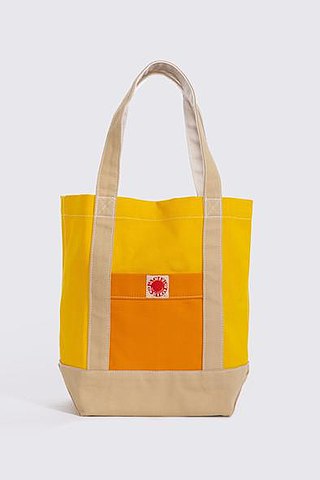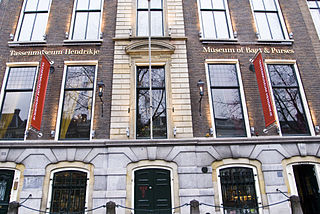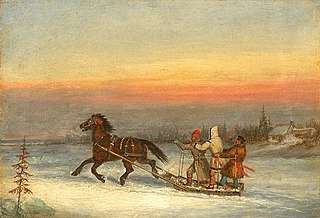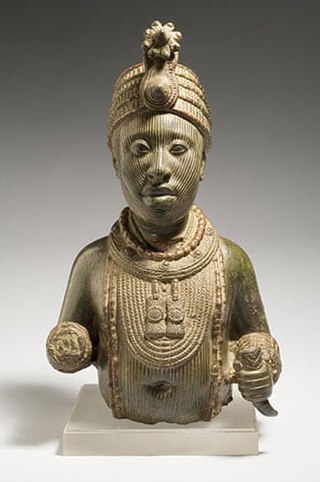
Beadwork is the art or craft of attaching beads to one another by stringing them onto a thread or thin wire with a sewing or beading needle or sewing them to cloth. Beads are produced in a diverse range of materials, shapes, and sizes, and vary by the kind of art produced. Most often, beadwork is a form of personal adornment, but it also commonly makes up other artworks.

Weaving is a method of textile production in which two distinct sets of yarns or threads are interlaced at right angles to form a fabric or cloth. Other methods are knitting, crocheting, felting, and braiding or plaiting. The longitudinal threads are called the warp and the lateral threads are the weft, woof, or filling. The method in which these threads are interwoven affects the characteristics of the cloth. Cloth is usually woven on a loom, a device that holds the warp threads in place while filling threads are woven through them. A fabric band that meets this definition of cloth can also be made using other methods, including tablet weaving, back strap loom, or other techniques that can be done without looms.

A parka or anorak is a type of coat with a hood, often lined with fur or faux fur. This kind of garment is a staple of Inuit clothing, traditionally made from caribou or seal skin, for hunting and kayaking in the frigid Arctic. Some Inuit anoraks require regular coating with fish oil to retain their water resistance.

A bandolier or a bandoleer is a pocketed belt for holding either individual cartridges or belts of ammunition. It is usually slung sash-style over the shoulder and chest, with the ammunition pockets across the midriff and chest. Though functionally similar, they are distinct from chest rigs, which are designed to hold magazines instead.

A waistcoat, or vest, is a sleeveless upper-body garment. It is usually worn over a dress shirt and necktie and below a coat as a part of most men's formal wear. It is also sported as the third piece in the traditional three-piece male suit. Any given waistcoat can be simple or ornate, or for leisure or luxury. Historically, the waistcoat can be worn either in the place of, or underneath, a larger coat, dependent upon the weather, wearer, and setting.

A handbag, commonly known as a purse in North American English, is a handled medium-to-large bag used to carry personal items. It has also been called a pocketbook in parts of the U.S.

Fashion in the period 1700–1750 in European and European-influenced countries is characterized by a widening silhouette for both men and women following the tall, narrow look of the 1680s and 90s. This era is defined as late Baroque/Rococo style. The new fashion trends introduced during this era had a greater impact on society, affecting not only royalty and aristocrats, but also middle and even lower classes. Clothing during this time can be characterized by soft pastels, light, airy, and asymmetrical designs, and playful styles. Wigs remained essential for men and women of substance, and were often white; natural hair was powdered to achieve the fashionable look. The costume of the eighteenth century, if lacking in the refinement and grace of earlier times, was distinctly quaint and picturesque.
Maude Kegg was an Ojibwa writer, folk artist, and cultural interpreter. She was a member of the Mille Lacs Band of Ojibwe, located in east-central Minnesota.
A pipe bag or tobacco bag is a common item used by some Native American ceremonial people. A pipe bag may be used to carry a sacred pipe, such as a Chanunpa.
The study of the history of clothing and textiles traces the development, use, and availability of clothing and textiles over human history. Clothing and textiles reflect the materials and technologies available in different civilizations at different times. The variety and distribution of clothing and textiles within a society reveal social customs and culture.

Grosgrain is a type of fabric or ribbon defined by the fact that its weft is heavier than its warp, creating prominent transverse ribs. Grosgrain is a plain weave corded fabric, with heavier cords than poplin but lighter than faille, and is known for being a firm, close-woven, fine-corded fabric. Grosgrain has a dull appearance, with little luster in comparison to many fabric weaves, such as satin, often used for ribbons; however, it is comparatively very strong. Grosgrain fabric is most commonly available in black, but grosgrain ribbon comes in a large variety of colors and patterns. The ribbon is very similar to Petersham ribbon in its appearance, but it does not have the ability to follow the curves of a surface or edge the way that the latter does.

A tote bag is a large, typically unfastened bag with parallel handles that emerge from the sides of its pouch.

The Museum of Bags and Purses, was a museum devoted to the history of bags, purses, and their related accessories. Located in Amsterdam's historic central canal belt, the museum's collection included over 5,000 items dating back to the sixteenth-century.

A money bag is a bag normally used to hold and transport coins and banknotes, often closed with a drawstring. When transported between banks and other institutions, money bags are usually moved in armored cars or money trains. It is a type of currency packaging. Money bags are often portrayed in cartoons and other light popular culture.

A string bag, net bag, or mesh bag is an open netted bag. Mesh bags are constructed from strands, yarns, or non-woven synthetic material into a net-like structure. String bags are used as reusable shopping bags and as packaging for produce.

A bag is a common tool in the form of a non-rigid container, typically made of cloth, leather, or other materials. The use of bags predates recorded history, with the earliest bags being lengths of animal skin, cotton, or woven plant fibers, folded up at the edges and secured in that shape with strings of the same material. Bags are used for carrying items like personal belongings, groceries, or other objects. They comes in various shapes and sizes, often equipped with handles or straps for easy carrying.

A capote or capot is a long wrap-style wool coat with a hood.

Emily Waheneka (1919-2008) was a Native American artist, of Warm Springs, Wasco and Paiute tribal heritage.
Maggie Thompson is a Native American textile artist and designer from the Fond du Lac Ojibwe with a focus on "knitwear and tapestry". Her work focuses on her heritage and identity and also addresses cultural appropriation and Native authenticity. She is the director of the Two Rivers Gallery in Minneapolis,

Odigba (Òdìgbà) is the name for a bound collection of cylindrical beaded strings, collars, necklaces or rope accessories in the Yoruba culture. The word anatomy of the term comes from the article pieces: -Odi; i.e. The bound or tied, and -Igba; meaning collar or cord.



















